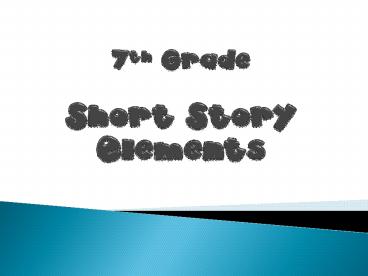the sequence of events in a story. has a beginning, middle, - PowerPoint PPT Presentation
1 / 19
Title:
the sequence of events in a story. has a beginning, middle,
Description:
The sequence of events in a story. Has a beginning, middle, and end. Short stories usually have one plot so it can be read ... Hyperbole Idiom. Irony Symbolism ... – PowerPoint PPT presentation
Number of Views:4618
Avg rating:3.0/5.0
Title: the sequence of events in a story. has a beginning, middle,
1
7th Grade Short Story Elements
2
major elements
- Setting
- Plot
- Conflict
- Characters
- Theme
3
Setting
- WHEN and WHERE a story takes place
- Usually includes
- Place
- Time
- Weather conditions
- Social conditions
- Mood or atmosphere
4
Plot
- The sequence of events in a story
- Has a beginning, middle, and end
- Short stories usually have one plot so it can be
read in one sitting - There are five essential parts of plot
5
Plot Diagram
C
D
B
A
E
6
A. Exposition
- Occurs at the beginning of a short story.
- Characters are introduced
- We learn about the setting
- We are introduced to the main conflict (main
problem).
7
B. Rising Action
- This part of the story begins to develop the
conflict(s). A building of suspense occurs.
8
C. Climax
- This is the turning point of the story. Usually
the main character comes face to face with a
conflict. The main character will change in some
way.
9
D. Falling Action
- All loose ends of the plot are tied up. The
conflict(s) and climax are taken care of.
10
E. Resolution
- The story comes to a reasonable ending.
11
A. Exposition B. Rising Action C. Climax D.
Falling Action E. Resolution
Beginning of Story
Middle of Story
End of Story
12
Conflict
- Is the opposition of forces it is any goal or
problem that the main character is faced with. - There are usually (but not always) multiple
conflicts, but only one main one.
13
- There are two types of conflict
- 1) External - A struggle with a force from the
outside. - 2) Internal - A struggle within (the character
must make some decision, overcome pain, resist an
urge, etc.)
14
- There are four kinds of conflict
- 1) Human vs. Human
- leading character struggles
- against other humans
- against animals
- 2) Human vs. Nature
- leading character struggles
- against nature
- against fate
15
- 3) Human vs. Society
- leading character struggles against beliefs or
customs of other people. - 4) Human vs. Self
- leading character struggles
- with ideas of right or wrong
- choices
- physical limitations
- etc.
16
CharacterS
- Protagonist is the main character of the story
(the hero) - all major events have some importance to this
character - Antagonist is whatever causes the conflict with
the protagonist (the villain, etc.) - can also be nature, society, etc.
17
Theme
- is the author's main idea or moral
- usually is what the main character learns about
life from overcoming the conflict - author may use figurative language to emphasize
his or her theme - Simile Metaphor
- Hyperbole Idiom
- Irony Symbolism
18
Examples of Theme
- Some simple examples of common themes in
literature, TV, and film - don't judge a book by its cover
- things are not always as they appear to be
- people are afraid of change
- love is blind
- believe in yourself
19
(No Transcript)































